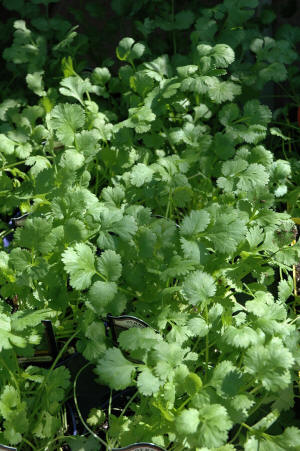|

Grow, Harvest, and Enjoy All Parts of Cilantro
By Melinda Myers
[March 29, 2025]
Growing cilantro is easy, but this cool-weather herb
quickly flowers and goes to seed as temperatures rise. This can be
frustrating as some vegetables typically combined with cilantro,
like tomatoes and peppers, ripen during the warmer summer months.
Try making multiple plantings, using all parts of the plant, or
growing more heat-tolerant options to extend your enjoyment.
Sow seeds every three to four weeks throughout the
summer for continual harvests if your summers are relatively cool.
Gardeners in hotter regions will have the best results growing
cilantro in spring, fall, and even winter when temperatures are
cooler. Grow cilantro in full sun or light shade as temperatures
climb and in moist, well-drained soil for best results. |
|
Mulching the soil with leaves or evergreen needles
helps keep the roots cool and moist, helping delay flowering. Avoid
overwatering, which can lead to root rot.
Cilantro grows quickly, and its leaves can be harvested when the
plants are four to six inches tall. Harvest as needed and as much as
a third of the plant at one time to allow it to keep producing. Or
cut the whole plant back to an inch above the ground and wait for it
to regrow. Cilantro should be harvested often to encourage new
growth and before the plants flower for the best flavor.
Store freshly cut leaves like a bouquet in a glass of fresh water.
Place in the refrigerator to use for the upcoming week. Hang leaves
upside down to dry or freeze. Just wash the leaves, pat dry, and
place them in a freezer bag or air-tight container in the freezer.
Or chop up the rinsed cilantro into smaller pieces, place in ice
cube trays, and top with a splash of water before placing in the
freezer.
Don’t be surprised as temperatures rise, the plant will flower and
set seed. Look at this as an opportunity to utilize the other parts
of this plant. Enjoy the beauty and flavor of the lacy white flowers
that attract beneficial insects to the garden.
Seeds will appear after the flowers fade. Wait for the plants and
seeds to turn brown if you plan to harvest and use the seeds, known
as coriander. Cut off the seed heads, place them in a paper bag, and
allow the seeds to drop to the bottom. The seeds are ground and used
in breads, cakes, pickling spices, and Asian food. Store in sealed
containers until ready to use.
You can also let the plant self-seed. Allow the seeds to drop to the
ground in the garden and grow new cilantro plants to harvest and
enjoy. Cilantro seeds sprout readily when soil temperatures are 55
to 68º F and the plants can withstand a light frost.
Don’t forget to harvest the roots. These have a strong peppery,
citrus spicy flavor, so are often used for seasoning Thai and
Vietnamese food. They taste best when harvested in the fall.
[to top of second column] |

Extend the season by growing more heat-tolerant
varieties that are slower to develop flowers and seeds like Slo-Bolt,
Longstanding, Cruiser, and Santo. Papalo, also known as summer
cilantro, has a similar but stronger flavor than cilantro with a
hint of citrus and mint and thrives in hot weather. You will only
need one or two plants since this annual grows up to five feet tall
and several feet wide. Harvest young leaves for the best flavor and
use only 1/2 or 1/3 the amount of cilantro called for in recipes.
Extend your cilantro harvest and enjoyment by utilizing every part
of the plant. Adjust your cilantro growing techniques and plant
selection to help beat the heat.
Melinda Myers has written more than 20 gardening books,
including the Midwest Gardener’s Handbook, 2nd Edition and Small
Space Gardening. She hosts The Great Courses “How to Grow Anything”
instant video and DVD series and the nationally syndicated Melinda’s
Garden Moment TV & radio program. Myers is a columnist and
contributing editor for Birds & Blooms magazine and was commissioned
by Summit for her expertise to write this article. Myers’ website is www.MelindaMyers.com.
[Photo courtesy of MelindaMyers.com]
 |